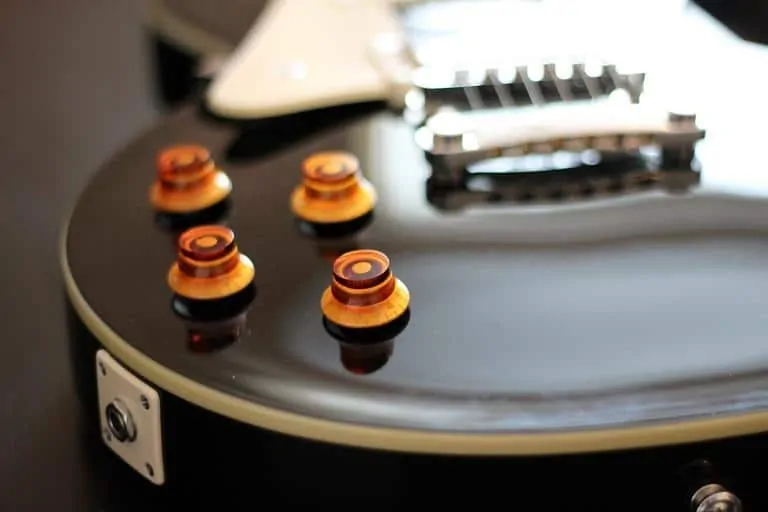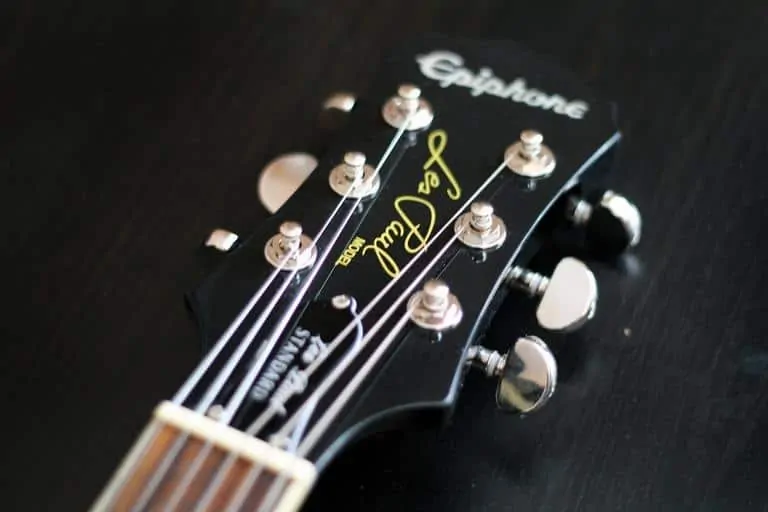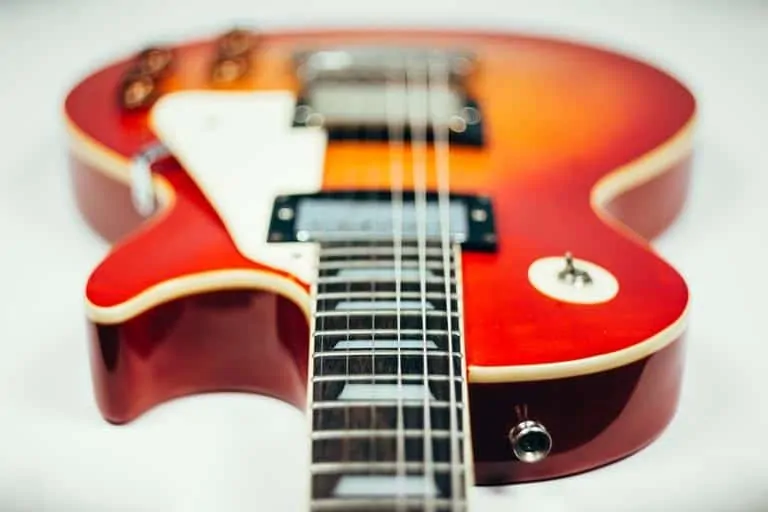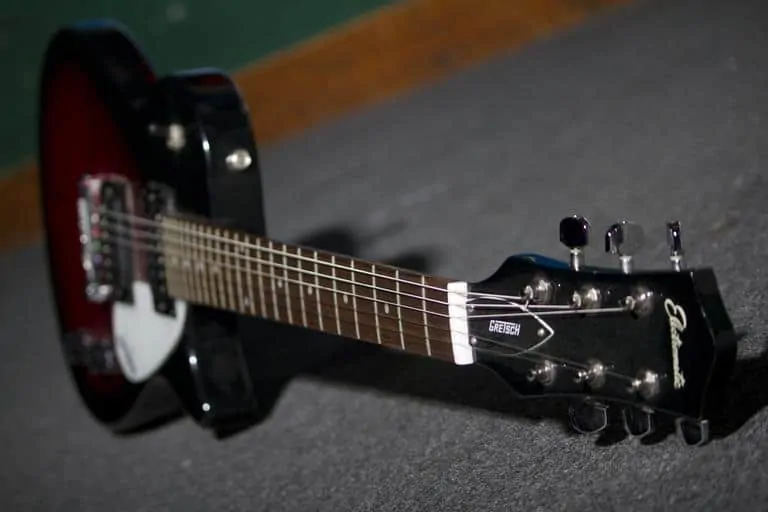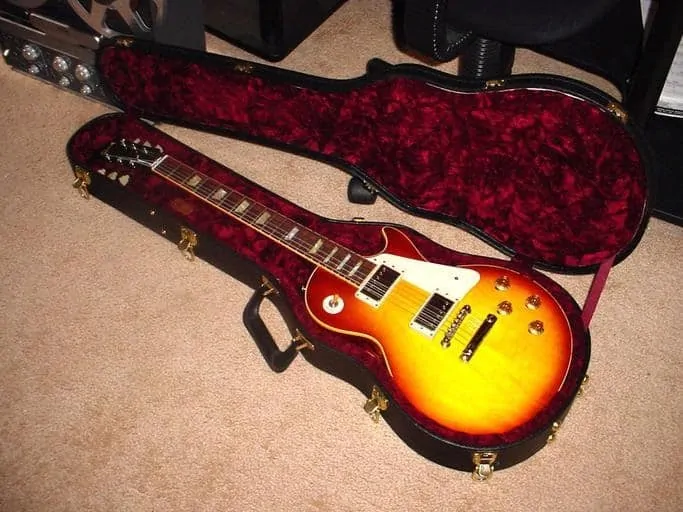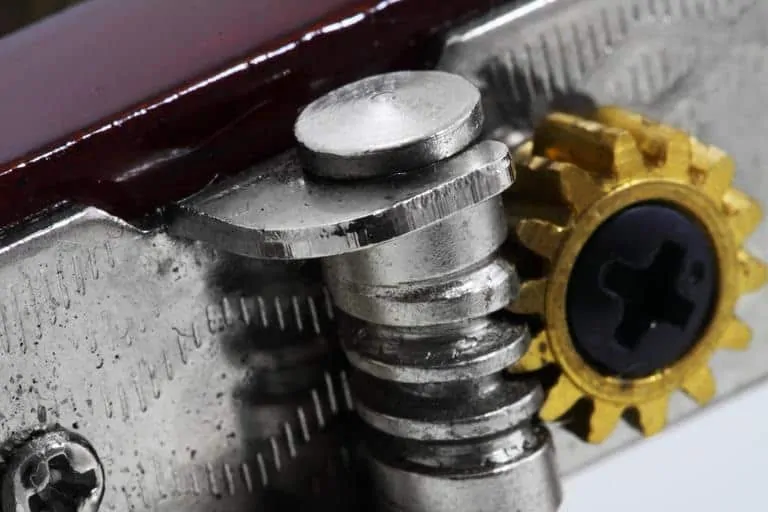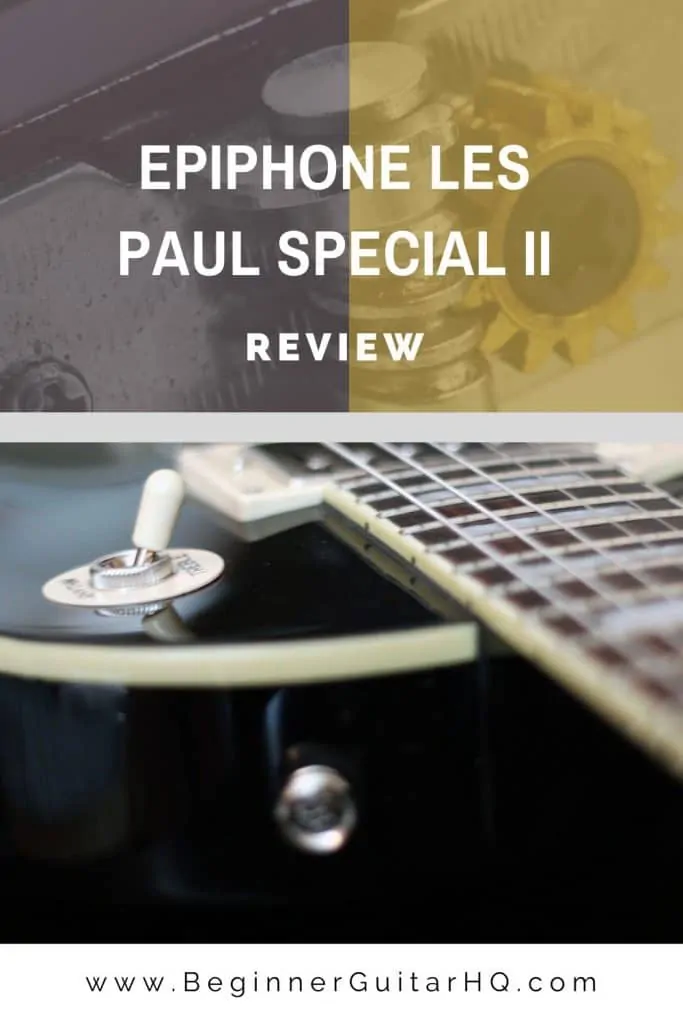We’ve highlighted and praised Gibson’s little sister Epiphone. However, we’ve never fully reviewed an Epiphone electric guitar, so we thought we could change that by reviewing the Epiphone Les Paul Special II electric guitar for beginners.
I’m writing this guide for the total beginner because I understand this is the kind of guitar first-timers are looking for. You can follow this article too if you’re simply looking for a budget-friendly guitar you can gift to someone else.
For now, take a look at the price of this Epiphone Les Paul guitar:
What we need to see is if this is really a Les Paul guitar at a price anyone can pay. Because, instead of a budget Les Paul alternative, this model could be the evidence of too many corners cut.
And because I’m writing this for beginners, we’re going to review a bit of history as well.
Epiphone is Gibson’s subsidiary creating cheap Gibson models like the Les Paul, the SG, or the Thunderbird bass.
Contents
About Epiphone
Gibson is a top music instrument manufacturer. Their offerings are as expensive as instruments can get, but they also pack premium sound, playability, designs, features, and aesthetics.
Only Fender competes against Gibson in terms of raw popularity and history. Both companies shaped the music industry with their revolutionary products back in the late ‘40s, which includes single-coil pickups (Fender), humbucker pickups (Gibson), P90 pickups (Gibson), hollow body electric guitars (Gibson), and solid-body electric guitars (Fender).
Epiphone was founded in Greece (1870) and then moved to New York by 1912 when the original founder passed away. Soon, the company was able to compete against Gibson and Fender. However, the brand had major financial troubles after WWII, an opportunity Gibson took to bring the Epiphone name under their V-shaped wings.
By the ‘70s, Epiphone was established as Gibson’s secondary brand creating original guitars like the Epiphone Elitist, or the Epiphone Sheraton.
Some of their older models are still in production and show how Gibson’s subsidiary is king when it comes to semi-hollow guitars. These models include the Epiphone Casino, the Epiphone Limited Edition ES-335, the Epiphone ES-339, and the Epiphone Wildkat entry-level hollow body guitar.
By the early ‘90s, they started producing cheaper Gibson guitars, which included the Les Paul, the SG, the Flying V, and the Explorer. There’s more info about these aggressive axes on the best guitars for rock guide.
So, Epiphone now works like Fender’s Squier brand. However, unlike Squier, Epiphone still creates premium instruments and signature models. Notably, they created Oasis’ Noel Gallagher’s Signature Epiphone Supernova guitar. And currently, Mastodon’s lead guitar player, Brent Hinds, plays with a Signature Epiphone Flying V Custom.
Nowadays, Epiphone is the go-to brand to find real Gibson budget alternatives.
The Epiphone Elitist series brings forward Epiphone vintage instruments with the higher quality standards the brand can offer.
About the Les Paul guitar
What we’re reviewing here is a Les Paul guitar at a price we can afford. See, the top Les Paul sells for a hefty price, and, while controversial, I’d say this is the best rock guitar there is in the market.
The Les Paul guitar changed the music world forever because its prototype was the first solid-body guitar to exist. A solid-body guitar is made on solid pieces of wood, unlike acoustic guitars or hollow/semi-hollow guitars.
Their sound is exactly what Lester William Polsfuss (Les Paul) was looking for when he released the guitar that bears his name in 1952. He just wanted the sound of the guitar string’s vibrations, not the whole guitar’s body.
Because Les Paul was known as a famous inventor and guitar tinkerer, Gibson’s chief Ted McCarthy approached him around 1946 to create this kind of guitar. And after many months of trial and error, they created the Gibson Les Paul Gold Top prototype
Still, Fender won the race by releasing the first mass-produced solid-body electric guitar, the Fender Broadcaster & the Fender Esquire (which later became the Telecaster). The Broadcaster appeared in 1948, whilst the Les Paul guitar appeared in 1952.
Les Paul, as well as Paul Bigsby (creator of the tremolo), were both known as guitar tinkerers. It is said that both inventors knew each other and created the first Les Paul prototype around 1948.
It wasn’t until Led Zeppelin’s Jimmy Page took the Les Paul after 10 years of firm Stratocaster lead when Gibson took hold on the premium guitar segment.
Most rock music has been made with a Les Paul: Jimmy Page, Jeff Beck, Slash, Zakk Wylde, Pearl Jam, Metallica, The Rolling Stones’ Keith Richards, Deep Purple, Frank Zappa, Stone Temple Pilots,… you name it.
Now, aside from Fender’s Stratocaster, the Gibson Les Paul is the most replicated electric guitar in the market. Many brands, both cheap and expensive, replicate the iconic LP single-cutaway shape.
Today, we’re looking at the cheapest “real” Les Paul there is, the Epiphone Les Paul Special II. It’s certainly a popular model for budget players and beginner musicians.
Epiphone Les Paul Special II Electric Guitar Review
The Les Paul Special II is the most affordable entry-level Les Paul guitar in the market. If you’re a beginner player, this lightweight model will suit right in your arms.
Or, if you’re a budget player looking for a backup partner, this is a strong choice.
The segment of beginner guitars is very tough. There is plenty of competition from no-name brands replicating Stratocaster bodies. There’s also plenty of competition from Ibanez, Dean, Peavey, and, most prominently, Squier.
Nevertheless, Epiphone has a strong position in the area with the LP Special II guitar, which is one of the most popular choices in the segment.
The model becomes even more with its “Player Pack,” a bundle that includes an Epiphone guitar amp, a bag, a cable, a strap, a set of picks, and a tuner.
You have to understand the Epiphone Les Paul Special II is the brand’s best selling model, and it’s not just about its affordability. It’s because of how much value it packs for the price.
Overview
The LP Special II packs two humbucker pickups in its body. These tapers are well above its price point, which is why they are a definite highlight. There’s more info about guitar pickups in this DiMarzio pickups guide.
This is a Mahogany-made guitar, which is a surprising choice as mahogany is a tonewood that usually belongs at higher price ranges. It also packs a Tune-O-Matic bridge, a piece of hardware you would find on a true Gibson Les Paul. In a similar fashion, it has the same mahogany neck Les Paul guitars pack.
These things alone make this a true Les Paul. There’re no shortcuts. Instead, it delivers the Slash sound o a budget, simple, and easy-to-play guitar.
Tonewoods refer to the hard pieces of wood used to construct a guitar. Each tonewood offers different tonal characteristics. They also come in different weights and natural colors.
Built Quality
The LP Special II is cut as the original Les Paul. And although the price is much, much less, it’s built with almost the same materials.
For example, mahogany is the standard tonewood for most Gibson instruments, which includes the Les Paul Standard.
Body & Design
First off, we’ve got a Mahogany single-cutaway Les Paul body. Mahogany is the same tonewood Gibson uses for its LP.
Mahogany is very popular because it’s the only hardwood that works on any part of every guitar. It shines because it’s a medium-weight timber that adds both punch and warmth. More so, it de-emphasizes the bass while enhancing the mid-range, which is the territory where electric guitars linger.
What it lacks, though, is the same kind of carved-top body you’d find on expensive LPs. A carved top body is a 3D contour made with computer-controlled carvers to enhance the sustain and enrich the tone of the guitar.
Instead, this is a simpler flat-body guitar, a decision Epiphone made to keep the weight under 10lbs, which is noticeably lighter than the Gibson Les Paul. And although you’re still going to feel the weight on your neck, at least you won’t feel the price of “Carved Top” Gibson guitars.
It does have a basswood top on the body, though, which adds extra points to the bass sounds and enhances the durability of the guitar.
Even so, tonewoods very rarely have any noticeable or significant tonal impact. The sound of a solid-body electric guitar depends almost entirely on its hardware (pickups, electronics, and bridge).
Moreover, tonewoods are less likely to produce any changes coming through budget guitar amps.
Now that we’re here, why don’t you check this list of combo guitar amplifiers to complete your first-timer guitar gear?
The original 1952 Gibson Les Paul Gold Top had a contoured top similar to a violin’s arched top. Gibson believed this decision would put their solid-body guitars far ahead of Fender.
Neck & size
The length of this guitar (measured from end to end) is 24.74’’, which is the same size as the Standard LP. This is a medium-scale body, a feature that enhances mid-range frequency sounds.
It has a mahogany bolt-on neck. A bolt-on neck is screwed onto the guitar’s body. The Gibson Les Paul features glued necks which enhances sustain and durability but also greatly increases the price.
Bolt-on necks are the standard compromise on entry-level guitars, and it doesn’t affect the overall aesthetics as the screws are on the back of the body.
The neck offers a nice 1960s SlimTaper D profile, which is LP’s vintage super-slim neck shape. It’s a beginner-friendly approach.
It has a rosewood fretboard with 22 medium jumbo frets and simple dot inlays. Rosewood is the typical choice for the fingerboard as it’s a smooth and naturally oily hardwood.
The fret ends (the edges) arent as smooth as I’d like. They feel a bit rough, a bit unfinished, but it’s still acceptable at this price range.
Lastly, it has a flat 12’’ neck radius. This is the curvature of the neck, and a 12’’ radius is the LP standard. It’s quite easy to get your hands around it.
Finish & colors
The Epiphone Les Paul Special II ships in two different colors. It comes in Vintage Sunburst, which is the classic ebony & black LP color; or it comes in Heritage Cherry Sunburst, which mixes gold & red colors in a similar pattern.
It doesn’t use any extra material for the finish of the guitar. Even so, It looks neat and has the feeling of a well-finished and put together guitar.
Vintage Sunburst is the most famous color for Les Paul guitars.
Sound Quality
So, what does a cheap Les Paul sound like? The truth is, not bad. It’s enough for beginner musicians, and it’s surprisingly nice for experienced players.
If you have a decent guitar amp, you could find some clarity, sustain, and warmth here. It’s more than enough to play most rock genres without sounding cheap.
Electronics
The electronics are quite basic but still functional. The LP Special II comes with two Epiphone high-output humbuckers. You can control these bobbins with a master tone and a master volume knob, plus a 3-way toggle switch that works like so:
- Left position: only the bridge humbucker is on.
- Middle position: both pickups are on.
- Right position: only the neck humbucker is on.
The knobs are quite limited, but these options are more than enough for beginner players.
Sound
The sound leans towards blues and classic rock, but it can go forward some heavier tones if you know how to use an overdrive pedal or a metal amp. In fact, you could even plug this into a tube amp for a crunchy sound, or use a metal distortion pedal for the most aggressive results.
Its pickups have plenty of power for heavier genres of music, which is quite nice. They are also better quality than what you’d find on your typical budget guitar.
And once you’re plugged, this beginner-friendly guitar is most definitely a Les Paul. It’s fat, heavy, warm, punchy, and well-balanced. The quality of its pickups is superb for the price, and although it lacks some clarity for the clean sections, they react well to distortions and offer hefty sustains.
Feel Quality
It’s surprising how this guitar approaches the Gibson Les Paul so much in terms of sound and build. But how does a super-cheap LP feel when you play it? Well, it feels great, in all honesty. And it’s mostly because of its hardware.
Hardware
By hardware, I mean the nut, the bridge, and the tuners. These three pieces must keep intonation and preserve the harmony of the guitar, and here’s where we become suspicious of most budget axes.
This is not the case with the LP Special II. First off, it has sealed machine heads for tuners with nickel buttons. They are more than okay, and they can even hold heavy de-tunes for the heaviest metal genres.
On the other side, it has Epiphone’s LockTone locking Tune-O-Matic style fixed bridge. It provides a good sustain, enhances intonation, and allows easy string changes. It also has a stop bar tailpiece, which increases sustain even more.
You would never get this guitar outside of its comfort zone with these two pieces. It can even hold a whole live set without giving you too much intonation issues.
It has a compromise, though which is the plastic nut. The nut is the piece you see at the start of the fingerboard. It keeps the sound clean by holding the strings tight as you play, and plastic is an unreliable nut material.
You can change all of the hardware pieces of any electric guitar.
Playability
This guitar feels fast and comfortable. It also feels lighter than the Gibson Les Paul, which is why it is a great choice for beginners and kids. Moreso, a light instrument is something you’d want to have for your long gigs.
It has a wide and flat 12’’ radius. A flat radius, allows you to go from chords to solos easily.
As I mentioned before, this is a flat-body guitar. Flat bodies offer increased access to the higher frets compared to the rounder and fatter carved-top body.
Overall, this is a relatively easy to play guitar for beginners and a really comfortable choice for experienced players.
Downside & Alternative
For the amount of value, it offers for the price, pointing out “downsides” is a cynical endeavor. However, this is a section I must write in order to give you additional options.
There’re three two things I dislike about this ax. First off, it has limited tonal shaping options with just two knobs. There’s nothing you could do about this, though. I
Secondly, the fret ends could be better. If this is an issue for you, you could go to a local luthier for a quick sanding process.
Having said that, if you have some experience, there are two things you could do to increase the value of this guitar by tenfold.
The first upgrade is changing the nut for a GraphTech Tusq nut. The one it has introduces a fair amount of fret buzz.
And then, naturally, you could change the pickups for top-quality humbuckers. See, this is a guitar with great playability and build, so changing the stock pickups would only make it much better.
I chose to mix a couple of Seymour Duncan Humbuckers: The SH-8 Invader for the bridge position (click here); plus a Seymour Duncan SH-4 Cebra for the neck (click here).
Lastly, if you want to get the most out of this guitar, you really need a mid-priced amplifier. That’s why I’m urging you to check our prior best combo amps list. If you’re looking for a premium practice amp, you can also check the Vox AC4C1-12 Mini Tube Amp.
That said, the bundled amps won’t do any justice to the LP Special II. Fender Squier also offers a bundle to start playing with, and I consider the packaged amp a bit better than Epiphone’s alternative:
Alternatively, you can check the Squier Bullet Stratocaster guitar.
Epiphone Les Paul Special II Guitar Specs
- Design: single-cutaway LP flat-top body
- Tonewoods: mahogany body with basswood top, mahogany neck, rosewood fingerboard
- Scale: 24.75’’ (medium-scale)
- Fingerboard: 22 medium jumbo frets
- Radius: 12’’
- Pickup configuration: Epiphone 650R Neck Humbucker & Epiphone 750T Bridge Humbucker
- Controls: Volume Knob, Tone Knob & 3-way selector switch
- Tuners: 14:1 sealed-machine tuning pegs
- Bridge: LockTune Tune-O-Matic bridge
In Summary
Why do I like the Epiphone Les Paul Special II guitar?
I think the reasons to like the Epiphone LP Special II are very clear. I’m even surprised because of how cheap this guitar sells.
Overall, it sounds great, it feels great, and it’s built great. Everything is well above its price point, and it does offer a Les Paul experience and sound for a budget. And even though the price is about 10 times less, it doesn’t sound cheap.
With a few upgrades, you could even think this is the real deal…if you forget about the logo on the headstock
What’s best, this guitar grows with you. For a minimal investment, you can go from bedroom player to live gig situations just by investing in better and better amps.
The Epiphone Les Paul Special II is excellent value for the money, and excellent pick for beginner players.

